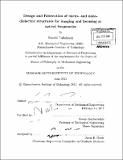| dc.contributor.advisor | George Barbastathis. | en_US |
| dc.contributor.author | Takahashi, Satoshi, Ph. D. Massachusetts Institute of Technology | en_US |
| dc.contributor.other | Massachusetts Institute of Technology. Dept. of Mechanical Engineering. | en_US |
| dc.date.accessioned | 2011-12-09T21:30:41Z | |
| dc.date.available | 2011-12-09T21:30:41Z | |
| dc.date.copyright | 2011 | en_US |
| dc.date.issued | 2011 | en_US |
| dc.identifier.uri | http://hdl.handle.net/1721.1/67602 | |
| dc.description | Thesis (Ph. D.)--Massachusetts Institute of Technology, Dept. of Mechanical Engineering, 2011. | en_US |
| dc.description | Cataloged from PDF version of thesis. | en_US |
| dc.description | Includes bibliographical references (p. 115-[121]). | en_US |
| dc.description.abstract | In this thesis work, design and fabrication of micro- and nano-photonic structures both in the diffraction regime and sub-wavelength regime have been investigated. In the diffraction regime, two types of optical systems and optical elements were investigated for application in LCD manufacturing. With the increasing demand for larger LCD screens at lower cost, technology for low-cost high-throughput manufacturing systems, as well as efficient repair systems within the manufacturing line for any manufacturing defects, are crucial for manufacturers. The first system investigated in this work is a novel optical lithography system for LCD manufacture using a computer generated hologram (CGH). The fabrication challenges for a highly complex pattern inherent in CGHs are addressed. The second system is a defect repair system utilizing a blazed grating matrix (BGM). The BGM generates multiple high intensity spots from a high-power pico-second pulsed laser, controlled by a spatial light modulator, which can ablate the surface of the substrate to eliminate residues and excess material. In both systems, high efficiency and pattern fidelity are required for the optical element, and micro- and nano-fabrication techniques were used in order to achieve the required specifications. In the sub-wavelength regime, locally periodic dielectric photonic structures with adiabatic variation were designed and verified, with application in lensing in optical frequencies. Structures such as rod lenses and Luneburg lenses are investigated. Especially the latter type of lenses have been conventionally difficult to implement in optical frequencies due to its specific refractive index profile. With the high flexibility of gradient effective index design with the " aperiodic" dielectric nanostructures, along with the design method using Hamiltonian Optics investigated in this research, the Luneburg lens was designed, fabricated, and verified at the wavelength of A[gamma] = 1.55[mu]m. | en_US |
| dc.description.statementofresponsibility | by Satoshi Takahashi. | en_US |
| dc.format.extent | 115, [6] p. | en_US |
| dc.language.iso | eng | en_US |
| dc.publisher | Massachusetts Institute of Technology | en_US |
| dc.rights | M.I.T. theses are protected by
copyright. They may be viewed from this source for any purpose, but
reproduction or distribution in any format is prohibited without written
permission. See provided URL for inquiries about permission. | en_US |
| dc.rights.uri | http://dspace.mit.edu/handle/1721.1/7582 | en_US |
| dc.subject | Mechanical Engineering. | en_US |
| dc.title | Design and fabrication of micro- and nano- dielectric structures for imaging and focusing at optical frequencies | en_US |
| dc.type | Thesis | en_US |
| dc.description.degree | Ph.D. | en_US |
| dc.contributor.department | Massachusetts Institute of Technology. Department of Mechanical Engineering | |
| dc.identifier.oclc | 764494293 | en_US |
